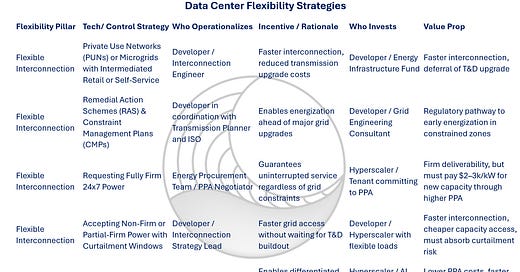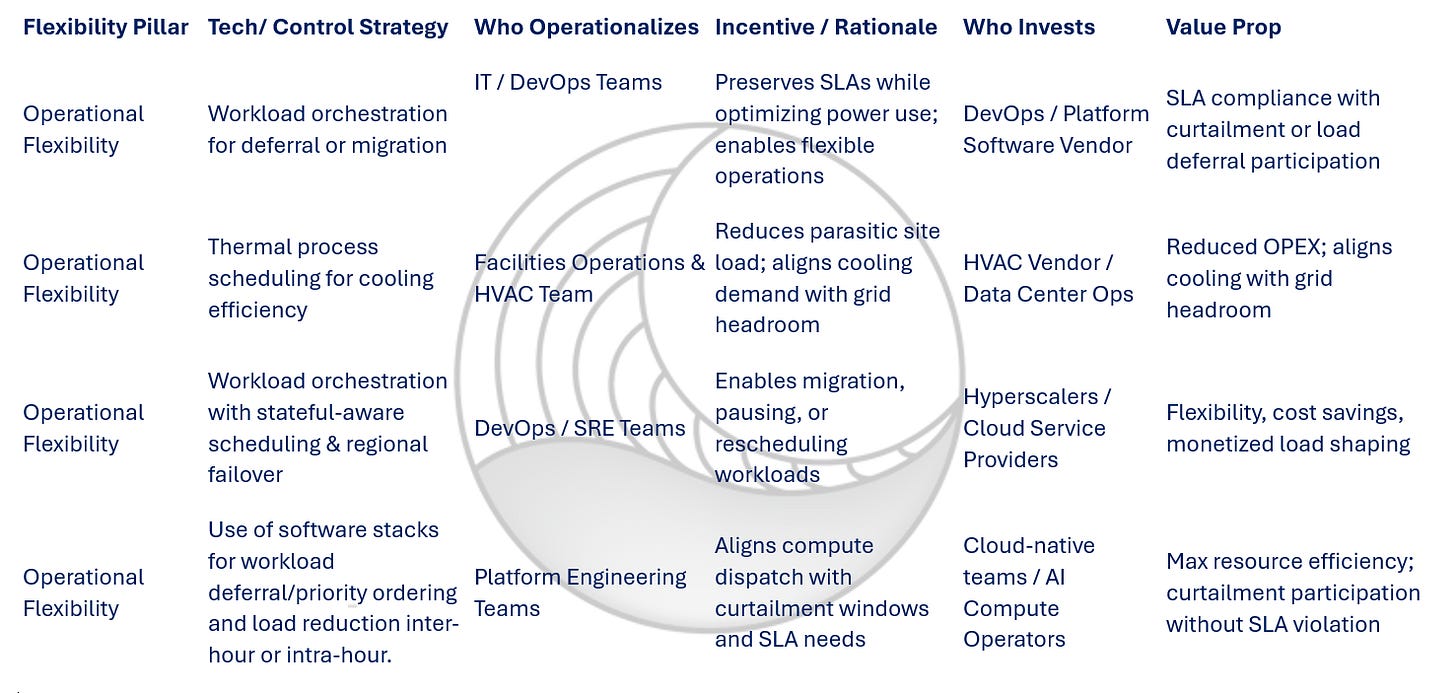What’s Actually in the Data Center Flexibility Toolbox?
A myriad of strategies in concert for AI Load Growth require a handshake between regulatory incentives and tech stack investment.
Power-hungry infrastructure is being built faster than power can be delivered. Data centers, in particular, are facing multi-year timelines for interconnection, even as demand accelerates. In that context, flexibility is no longer a nice-to-have—it’s a prerequisite for getting projects energized on any reasonable timeline.
This table is meant to serve as a working reference for that problem. It organizes the most practical, currently deployed strategies for accelerating interconnection, supporting operational flexibility, and making better use of grid and site-level resources. These strategies are already being used by developers, hyperscalers, cloud teams, and grid planners to bridge the gap between what’s needed and what’s actually possible within today’s regulatory and physical constraints.
Rather than focus only on technologies or only on market mechanisms, the table brings both together. It spans the interconnection process, site engineering decisions, control room software, and workload management tactics—because in practice, all of these interact. A partial-firm PPA doesn’t work without curtailment-tolerant compute. A battery doesn’t add value unless the control system can align it with grid events. And a site that chooses its location based on transmission topology is already doing load flexibility before the first trench is dug.
Each row in the table includes the core strategy, who typically implements it, the underlying rationale, who funds or procures it, and the value it provides. The result is a toolkit—for planning, for operations, for procurement, for regulatory engagement—that reflects how the most ambitious projects are actually getting built and connected.
While I’d like to say this is a vision document, I think it is actually a field guide. I’ve been in the field a long time (my workboots are Chanel, by the way), and so have most of my “friends and family” in the power business. The long-game for data center development at AI-powering scale will mean a lot of us are going to find boots to put on, and we will need regulatory and policy price signals to motivate the technical jazzercise that is necessary to move quickly.
What the Table Covers
This is a reference sheet for people trying to plan, connect, or operate large energy loads—and looking for ways to do it smarter. Each row shows a real strategy used in today’s grid environment to:
Accelerate interconnection
Avoid major transmission upgrades
Improve onsite resilience and flexibility
Make better use of what’s already been built
It covers technologies and approaches across five main categories:
Flexible Interconnection – Things like constraint management plans, partial-firm power, or SCADA systems that let a site connect sooner—even if there’s not full capacity available yet.
Integrated Onsite Resources – UPS systems, batteries, gensets, and temporary reciprocating engines used to manage peak load, support ride-through, or serve as placeholders until firm grid power is available.
Location-Based Load Shifting – How site selection, network architecture, and DNS-based traffic steering can reduce exposure to congestion or curtailment.
Operational Flexibility – Software and operational tactics that adjust compute loads in response to grid needs, including workload deferral, thermal optimization, and demand response.
Workload and Platform Tools – Orchestration layers that help align dispatch with grid conditions—without breaking service-level guarantees.
Why This Exists
The grid is not built for speed. But the demand growth we’re seeing—especially from AI and cloud—is. That mismatch means we need more than just infrastructure buildout. We need to use the infrastructure we already have more intelligently.
That’s what this table tries to show: the full range of tools and tactics that exist today to do exactly that. It is not exhaustive, but it is broad enough to give anyone—developers, utilities, regulators, engineers—a common language for talking about flexibility in a grounded, operational way.
Every campus, every tranche of data center development does not need to use every row in this table. But the more of these strategies site planners understand how to leverage, the better their odds of moving a project forward when the grid itself says “not yet.”
Enjoy the read, and please share with your state regulators, utility planners, and grid forecasting teams. - A.S.F.







